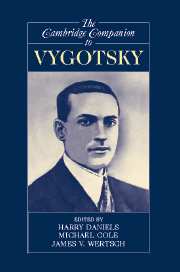Book contents
- Frontmatter
- Editors’ Introduction
- Part I: Vygotsky in Context
- 1 Vygotsky in Context: 1900-1935
- 2 Vygotsky’s Demons
- 3 An Interesting Resemblance: Vygotsky, Mead, and American Pragmatism
- 4 Vygotsky, Mead, and the New Sociocultural Studies of Identity
- 5 Vygotsky on Thinking and Speaking
- Part II: Readings of Vygotsky
- Part III: Applications of Vygotsky’s Work
- References
- Index
5 - Vygotsky on Thinking and Speaking
from Part I: - Vygotsky in Context
Published online by Cambridge University Press: 28 November 2007
- Frontmatter
- Editors’ Introduction
- Part I: Vygotsky in Context
- 1 Vygotsky in Context: 1900-1935
- 2 Vygotsky’s Demons
- 3 An Interesting Resemblance: Vygotsky, Mead, and American Pragmatism
- 4 Vygotsky, Mead, and the New Sociocultural Studies of Identity
- 5 Vygotsky on Thinking and Speaking
- Part II: Readings of Vygotsky
- Part III: Applications of Vygotsky’s Work
- References
- Index
Summary
Vygotsky's most popular book in the English-speaking world, Thought and Language, was first published in English in 1962. (It was originally published in Russian in 1934.) When retitled Thinking and Speech in 1987, it captured a more active notion of these interrelated processes. They are seen as activities rather than entities and the book explores the developmentally changing relationship between intellectual and verbal processes. Vygotsky viewed speaking and thinking as dynamically related and approached their connection as
The complex movement from the first vague emergence of the thought to its completion in a verbal formulation. . . . Thought is not expressed but completed in the word. . . . Any thought has movement. It unfolds. . . . This flow of thought is realized as an internal movement through several planes. As a transition from thought to word and from word to thought. (Vygotsky, 1987, pp. 249-250)
Thinking and Speech presents important distinctions between communicative language and language used for conceptual representation. By addressing such broad themes, Vygotsky's work was grounded in philosophical, psychological, and linguistic traditions that have influenced Western students of language. Within these disciplines, the relationship between thinking and speech was forged, and it is still of great concern to contemporary thinkers. Part of what is so interesting about revisiting this relationship is that it emerges repeatedly across disciplines and informs every aspect of the human sciences.
- Type
- Chapter
- Information
- The Cambridge Companion to Vygotsky , pp. 136 - 152Publisher: Cambridge University PressPrint publication year: 2007
- 15
- Cited by



